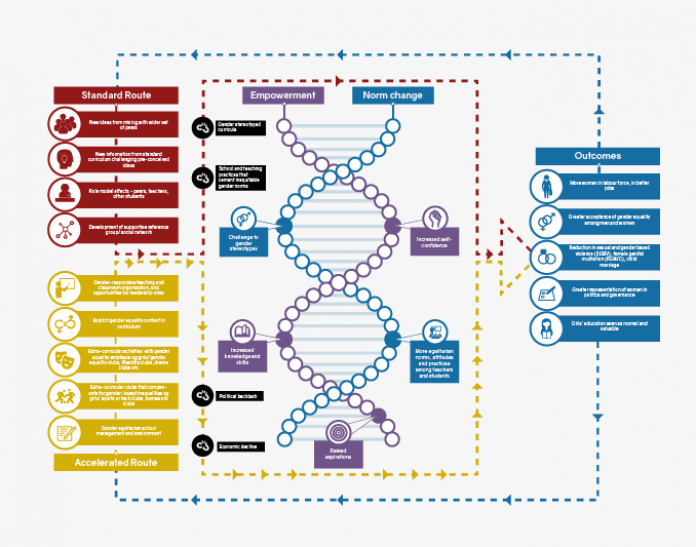
In this guide
Hide menu1. Introduction and key concepts
Show sections1. Introduction and key concepts
This ALIGN guide – currently being updated - is an introduction to education and gender norms. For more detailed analysis, please see our other education products.
Education is a powerful driver of gender equality because it empowers individuals and enables them to challenge discriminatory gender norms – the informal, often implicit, rules of masculinity and femininity that most people follow.
How does education change gender norms? It creates a potentially virtuous cycle, whereby education leads to changes in gender norms, and these changed norms contribute to improved learning outcomes. But this process is not automatic; prevailing gender norms and gender discriminatory practices in schools and in wider society can undermine the potential of education to bring about changes.
Gender norms exert a strong influence both on children’s access to education and their educational experience. For girls, these norms often become stronger during adolescence, when the need to protect their own (and their family’s) reputation often limits their mobility and their contact with boys outside the family.
Gender norms and stereotypes often reinforce one another in education. The norm that girls should defer to boys feeds a stereotypical view that girls are less capable academically, while expectations that their home-making role is more important than their future in the labour market can lead teachers to prioritise the boys in their classes.
Three other widely used concepts relate to education and changing gender norms: capability development, agency and empowerment.
Capability development means, according to Nussbaum (2003), expanding the range of things people can be and do – an expansion that typically occurs during our education when we learn new knowledge and skills and change our aspirations.
Agency is our capacity to act in ways we have chosen, and is often seen as a key capability for a fulfilling and productive life (see, for example, Ross et al., 2011). Education develops agency through its impact on aspirations, skills and self-confidence.
Empowerment (the most widely used of the three terms) is the process of gaining greater control over decisions that affect our lives. This is often underpinned by both the development of capabilities and a shift in the power relations associated with (in this case) changing gender norms.
This thematic guide brings together the evidence on this issue to unpack the concepts around gender norm change and educational processes, highlighting:
- Gender norms and educational access
- Gender norms and educational achievement
- Education as a driver of gender norm change
- Case studies
- Useful resources: toolkits and further reading.
While this guide focuses on formal education, it does include information on informal education in relation to girls clubs. The guide sets out the links between education, empowerment and gender norm change, as shown in this interactive diagram, which explores standard, accelerated and interrupted routes to gender norm change.
Explore this interactive diagram on standard, accelerated and interrupted routes to gender norm change.
